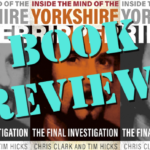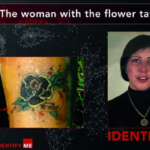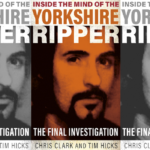Book Review: “Yorkshire Ripper – The Secret Murders” by Chris Clark and Tim Tate
Some personal background
As a young man, I remember following the Yorkshire Ripper investigation and the trial in which Peter Sutcliffe – a lorry driver from Bradford – was convicted of murdering thirteen women and attempting to murder another seven between 1975 and 1980.
This was, up to that time, the biggest police investigation ever undertaken in Britain. It was a major national story, covered in great
detail by all media outlets. However despite this, I think that those – like myself – who did not live in present day West Yorkshire and
Manchester at the time, cannot conceive of the fear Sutcliffe inflicted on women in the North of England during his reign of terror.
For those that are unfamiliar with the Yorkshire Ripper case, there is a very good documentary:
I was reminded of the case recently by an article on the BBC confirming that Sutcliffe had just been eliminated as a suspect in the murder of two women in Sweden in 1980. I had always felt unease at the way the Ripper investigation had been performed and was astounded that even now, the full range of Sutcliffe’s offending has still not been determined. Hence my purchase of “Yorkshire Ripper – The Secret Murders” by Chris Clark and Tim Tate.
It was a very good buy, but makes disturbing reading. My thoughts on it are below, in the form of an NYE book review.
Review
Tim Tate is an author, film maker and award winning investigative journalist who covered the Yorkshire Ripper investigation as a young reporter on the Keighley News. Chris Clark is a retired police intelligence officer from Norfolk Constabulary. He was not involved in any way with the original Ripper enquiry. This unusual combination of backgrounds has given them the mix of skills and objectivity required to write an impressive, impartial and incisive book.
The book is three hundred and fifty-eight pages, with forty-four black and white photographs. It contains two tables showing the common elements in Sutcliffe’s modus operandi for (a) the twenty attacks on women Sutcliffe was convicted of, and (b) the additional
forty-four vicious attacks on women (twenty-two of them murders) which the authors suggest/deduce were committed by Sutcliffe.
Tate and Clark further assert that these attacks occurred all over England, not just in areas close to Sutcliffe’s home. For each attack they attribute to Sutcliffe on the basis of his modus operandi, they also coordinate his movements, both as a lorry driver and in connection with his personal visits to family members. They assert that Anthony Steel, Stephen Downing and Andrew Evans were imprisoned for attacks that were in fact committed by Sutcliffe.
As one would expect from a long serving intelligence officer, the intelligence failures are perfectly covered. This includes the impact of force amalgamations, failures of various police forces to work together and pass on information, failures in keeping accurate criminal records and the failure of the British Police Service to have evolved appropriate intelligence systems and data processing resources, for an investigation of this size. The absence of geographic profiling is also analysed.
The psychological side of the Ripper investigation is examined very clearly. The development of psychological profiling, the differences between organised and disorganised serial killers, the difference between Modus Operandi and signature, the clinical characteristics of a necrophile killer that poses bodies are all explored in simple terms. As is the failure to identify that Sutcliffe was a necrophile serial killer, not a person motivated by a hatred of prostitutes and the impact it had on the investigation.
The book also covers the case more generally. The investigative failures, failures in leadership and concerns within the Home Office, the furore when it became clear the investigation had been bungled and the associated parliamentary criticism are well described.
The trial and the M’Naghten rules (pronounced MacNaughton rules) for determining if an accused was fit to plead are explained particularly well. Showing how Sutcliffe nearly succeeded in manipulating psychiatrists and the prosecutors at his trial, to secure a conviction of manslaughter due to diminished responsibility. Thereby ensuring he was committed to a psychiatric hospital not a maximum security prison. Only the sage intervention of His Honour Mr Justice Boreham prevented what would have been a very grave miscarriage of justice.
The final chapters, entitled “Cover Up” and “Aftermath”, describe how the reports into the Yorkshire Ripper Investigation by Assistant Chief Constable Colin Sampson of West Yorkshire Police and Chief Constable Lawrence Byford of HM Inspectors of Constabulary were supressed. Chillingly, Chief Constable Byford commented “It is my firm conclusion that between 1969 and 1980 Sutcliffe was responsible for many more attacks on women…”.
The report by Detective Constable Andrew Laptew recommending further investigation of Sutcliffe, which if acted upon would have led to his arrest also disappeared. Exhibits were destroyed. Tate and Clark then describe how in response to their enquiries, Police forces refused to re-open cases to consider if Sutcliffe was responsible for unsolved crimes in their area and files were withheld. Thereby preventing resolution of these cases and closure for the victims and their families.

At £4.95, I felt it was excellent value for money, not just for the amount of information it contained, but for the clarity of analysis on a wide range of complex subjects and the quality of the writing. It was easy to read and summarised an enormous amount of painstaking investigative work in a gripping narrative. I have no doubt if this book had been published in 1981, it would have caused an outcry and major reform of the police. The only (minor) criticism I have is that it would benefit from an index and a map showing Sutcliffe’s offending and alleged offending.
Highly recommended. It should be required reading for all police intelligence officers, Chief Police Officers and those detectives that aspire to lead/participate in large, complex, cross force investigations.
“Yorkshire Ripper – The Secret Murders” by Chris Clark and Tim Tate is available from John Blake Books price £4.99.
- ISBN: 9781784186906
Website link below:
https://johnblakebooks.com/yorkshire-ripper-the-secret-murders-ebook.html








![Death of Sir Lawrence Byford [Obit.]](https://nyenquirer.uk/wp-content/uploads/2018/02/SIR_LAWRENCE_BYFORD-150x150.jpg)




